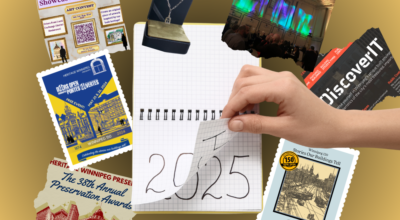
/ Blog
February 16, 2023
Part Two: Sound The Alarm! Winnipeg’s Heritage Is Burning Down
Why is Winnipeg’s heritage burning down? This is not a new problem, from its earliest days, fire has been the demise of many buildings in Winnipeg – sometimes in spectacular fashion, sometimes with tragic consequences. In the first part of this blog, published last month, we looked back at some memorable historic fires in Winnipeg and started to examine why heritage buildings are at risk of fire today. In this second part of the blog, we will continue the discussion of what factors increase the chances of a fire in a heritage building, what the City of Winnipeg is doing to mitigate the risk and what strategies can be implemented to reuse vacant buildings before they are turned to ashes. How can Winnipeg use heritage buildings to ignite vibrant, thriving communities instead of letting problem properties smolder until everything goes down in flames?
Renovation and rehabilitation work can be a high risk activity in heritage buildings with “hot works” that use open flames, produce sparks or create high temperatures being potential ignition sources. Hot particles that drop out of sight can burn down the whole building hours later if they go undetected. Temporary electrical systems can be hazardous especially while the building is filled with combustible construction materials. Making matters worse, construction often lessens the effectiveness of fire detection and suppression systems, which end up taken out of service, smothered in dust and more. At the same time, renovation and maintenance of heritage buildings are both important steps in minimizing fire risks. They are an opportunity to bring a building up to and beyond modern codes, install a sprinkler system and correct any earlier modifications that have reduced the building’s fire safely, such as removing doors. Routine maintenance then ensures all systems are in good working order, especially electrical ones, so they are not needlessly starting fires.
Winter further increases the risk of fire in all types of buildings, including heritage ones, for several reasons. Heating equipment is a major cause of winter fires, with dirty chimneys, crowded or old heaters and fuel spills all being common causes. Pretty much everything about the holidays increases the risk of fire, including lighting candles for ambiance, deep frying a turkey for dinner or having a live Christmas tree – there are so many hazards! Well not every building will face the risks associated with the holidays, all buildings should be heated during a Winnipeg winter, especially heritage ones.
Of late, one of the biggest fire risks for heritage buildings is arson. This is a particularly challenging risk to mitigate, but efforts can be made. Vibrant, occupied, well maintained and well lit buildings are less enticing, and in some situations security of some sort can be used to detect and keep unwelcome visitors out. As most arson fires are started outside a building, it is important to remove sources of fuel around buildings, like trash and vegetation. The accumulation of flammable material inside heritage buildings should also be kept to a minimum and properly secured. Vacant heritage buildings are at an even greater risk for arson and require extra precautions to help keep them safe. They should be correctly secured and boarded up as required under the City of Winnipeg’s Vacant Building Bylaw. Properly mothballing a heritage building not only helps lower the risk of arson but also helps protect the building from decay due to weather and water damage. Highly visible security can also help deter crime, and the building should be regularly monitored, with any issues quickly resolved. Finally, a marking system posted on the outside of vacant heritage buildings can help save firefighters’ lives, giving a visual indication of what the hazard level is expected inside or if it is even safe for them to enter in the case of an emergency.
Vacant buildings have become a hot spot for fires in Winnipeg this winter, with six fires in vacant buildings in the month of January alone. Even more frustrating is the reality that several of these buildings have been burnt previously. People breaking in and lighting fires to keep warm are the suspected culprit, unintentionally putting firefighters and the community at risk while destroying potentially viable buildings. There is also frustration from community advocates because not all of these buildings are required to be boarded up, making it easier for people to gain access to them. The City changed the Vacant Building Bylaw to increase fees for owners of vacant buildings to deter them from keeping buildings empty, but if the high number of fires this winter is any indication, the fee is not making a big impact. On January 9th, 2023 a proposal was made at City Hall to charge vacant building owners the cost of fighting a fire at their structure. The Standing Policy Committee on Property and Development unanimously approved the proposal, recognizing the $1.4 million that could have been recouped by the City if the legislation was in place from 2019 to 2021. The change to the Vacant Buildings Bylaw would make concessions for fire started on another property, caused by natural disaster or by a vehicle colliding with the building, but would otherwise charge the building owner $340 per hour for a district chief and driver attending the fire and $1357 per hour for pumper/aerial ladder/rescue resources.
Well this change in legislation is certainly a step in the right direction, it does not address the root of the problem – vacant buildings. A City report says there are 683 vacant buildings in Winnipeg, suffering about 40 fires a year from 2019 to 2021. In a city struggling with housing, especially affordable housing, it is terrible for heritage buildings to be sitting vacant and neglected, waiting to see how long it takes before disaster befalls them. Fees clearly are not enough of a deterrent – the historic Rubin Block at 270 Morley Avenue has survived two fires – 2006 and 2014 – and has been sitting vacant since 2015. While the community has formed an advocacy group to try and get the building sold or renovated, the owner seems unwilling, allowing the much needed affordable housing to continue to decay. Heritage Winnipeg along with the Rubin Block advocates fear it is only a matter of time before the building is lost – to fire or to neglect.
How do we change the fate of Winnipeg’s vacant heritage buildings, and vacant buildings in general? While vacant buildings contribute nothing positive to their community, suddenly knocking them all down would be a horrible waste of resources. At the same time, suddenly getting them all redeveloped and occupied is an impossible feat. Larger buildings that take millions of dollars to redevelop may need to sit empty for several years until an appropriate project is ready to reincarnate them. While smaller buildings might be easier to redevelop in the short term, there is the reality that the owner may have no interest in selling or engaging with a project. As the City can only start the arduous process of taking title of a building after property taxes have gone unpaid for three years, neglectful owners that are dragging down their communities will not be moving out any time soon. It is a frustrating situation, and the City does not want to engage in the legal battle to take title of a property any more than it wants to be responsible for owning vacant buildings. But while no action is taken, everyone suffers from the plague of vacant structures that cause rising crime, declining property values and a shrinking housing stock.
Winnipeg is not the only city faced with too many vacant structures. In the United States, a variety of strategies have been used to combat the problem. While every context is different and therefore requires an individualized approach, perhaps these strategies can be used as inspiration for Winnipeg going forward? The first step in addressing vacant buildings is usually gathering comprehensive and accurate data on them. It is impossible to fix a problem if you do not know what the problem exactly is. Next, a land bank, either public or nonprofit, is established to acquire vacant buildings through a variety of means, including tax foreclosures and open market purchases. An initial source of funding is required to start a land bank, after which the sale of redeveloped buildings funds future purchases and renovations. Part of the strategy to redevelop vacant buildings could also be providing a means, financial or otherwise, for qualifying families to purchase and renovate vacant residential properties that are well built and are still able to serve the community. These newly rehabilitated and occupied homes would not only provide much needed affordable housing, but also help decrease crime, increase property values and property tax revenue, and result in the city spending less resources on inspecting vacant properties or fighting potential fires. This type of strategy would be particularly advantageous in low socioeconomic areas, which tend to have a higher concentration of vacant properties at risk, less resources to address the problem and a higher need for affordable housing.
In starting to gather information on vacant buildings and redevelop them, there also needs to be the realization that not every property can be saved. Strategic demolition can weed out buildings that are too far gone or pose a safety risk, and leave more resources for other projects. But demolishing buildings does not resolve all the issues, as empty lots can be just as problematic as the vacant building that once stood on them. Partnering with the community to develop these green spaces, even if it is temporary, is key. Some cities have even taken on the responsibility of converting empty lots into parks, regardless of whether or not the city owns the property. And while vacant and demolished buildings are being resolved, cities need to ensure codes are being enforced so more buildings are not left empty and falling into disrepair. Finally, all stakeholders need to work cooperatively towards achievable and measurable goals with transparency and strong communication. From governments to nonprofits to community members, everyone needs to be willing to work together and leverage all available resources to find creative solutions to tackle such a big problem.
Fire is a dichotomous force, it can be both life giving and life ending. For Winnipeg’s heritage buildings, particularly the vacant ones, it can be a death sentence, wasting non-renewable resources and needlessly endangering lives. Although there are no easy solutions, action needs to be taken before more lives and more heritage buildings are lost. The negligent acts of a few building owners should not be causing the entire city to suffer. Heritage Winnipeg is hopeful that introducing a firefighting fee is the first step towards persuading vacant heritage building owners to redevelop or sell their structures, and that the City of Winnipeg will work more collaboratively with our organization on these issues going forward. We need to think of innovative ways to reuse these properties and as experienced stakeholder in the heritage community, we can be of immense help. Built heritage is an irreplaceable resource, not only for the history it holds but for the way in which it can serve its community – past, present and future. How many buildings have to go up in flames and how many lives have to be lost before Winnipeg gets serious about addressing the issue of vacant buildings? When it comes to built heritage, there is simply too much to lose if we let it all burn down.

The Radford-Wright Building at 776 Main Street was set on fire by serial arsonist James Dodds on March 9, 1912. The fire caused a huge explosion that killed seven people (two firefighters and five spectators including a twelve year old boy) and horrifically injured many more. When caught a year later still setting fires, Dodds would confessed to setting 92 fires, although it was suspected that the actual number was closer to 200. Although Dodds was found guilty of committing arson, he was sent to a mental health facility instead of jail before being deported back to Scotland in October 1913.
Source: PastForward (Winnipeg Public Library)
THANK YOU TO THE SPONSOR OF THIS BLOG POST:

Written by Heritage Winnipeg.
SOURCES:
$2.4M Bannatyne historic apartment fire was arson: Winnipeg police | CBC News - May 14, 2015
Arson Prevention | Red River Mutual
Barber House: 99 Euclid Avenue | Historical Buildings Committee - City of Winnipeg - July 24, 1979
Better alarm, sprinkler system could have saved Leland: report | Keith McArthur - Winnipeg Free Press - April 9, 1999, page A6
Council presses ahead with downtown initiative | David O’Brien - Winnipeg Free Press - May 27, 1999, page A8
The end for Noble Court? | Christian Cassidy - West End Dumplings - October 29, 2016
Heritage evaluation | Parks Canada - Government of Canada - November 19, 2022
Holidays Most Dangerous Time for House Fires | Enjoli Francis - ABC News - December 20, 2011
Holy Trinity Ukrainian Orthodox Cathedral | Winnipeg Architecture Foundation
How Cities Are Using Innovation To Combat Vacant Properties | GovPilot
Modern homes burn 8 times faster than 50 years ago | CBC News - Sepember 13, 2013
Put A Freeze on Winter Fires | National Fire Protection Association
Reducing Arson at Vacant and Abandoned Buildings | U.S. Fire Administration
Reducing arson risk | London Fire Brigade
Strategies for Vacant and Abandoned Property Reuse | PD&R Edge
Why historic buildings are at risk of burning down | Adam Šapić - Wedding Insurance Group
Winnipeg's 5 Deadliest Fires | Christian Cassidy - West End Dumplings - February 8, 2013












